Learn how to make the best Baked Salmon recipe using a sheet pan or baked in foil, with several different salmon seasoning options.
Looking for more seafood recipes? Try my Easy Homemade Crab Cakes, Seared Scallops, or learn How to Cook Crab Legs!
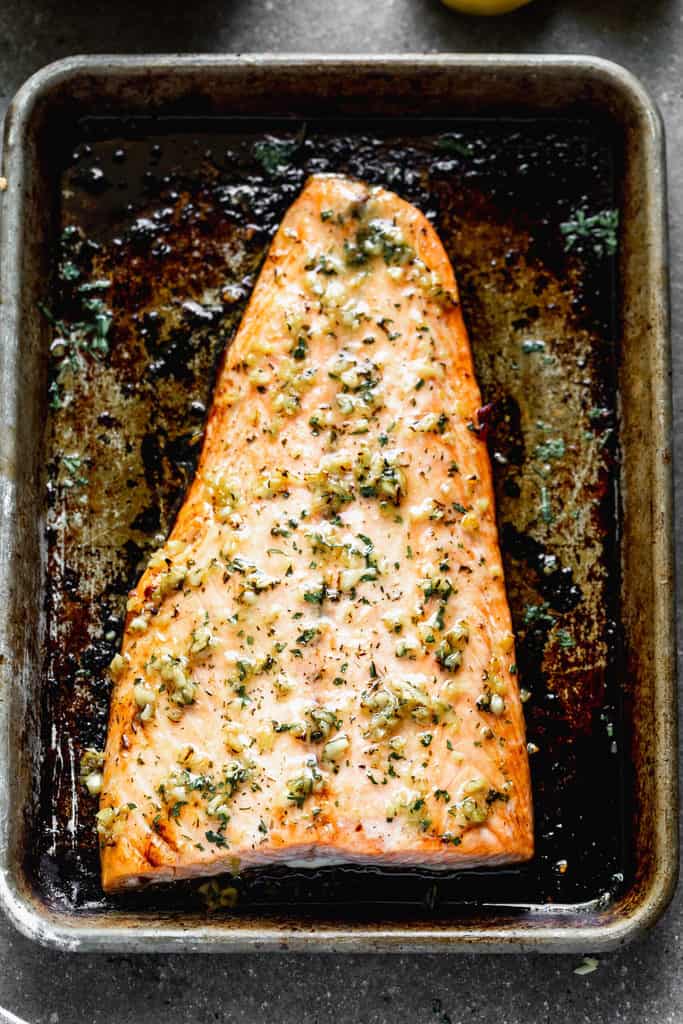
Why I love this recipe:
Healthy – You can’t beat a fillet of perfectly cooked salmon next to a nice salad or roasted vegetables. It’s delicious and leaves you feeling full of energy!
Easy – Follow my step-by-step instructions and tips you won’t believe how easy perfectly cooked salmon can be!
Versatile – I have included three different seasoning options for you to choose from, and you can also choose to bake the salmon in foil or on a sheet pan.
How to Bake Salmon:
- Rest salmon. Set salmon on counter and allow it to rest for 20-30 minutes to come to room temperature. Pat with a paper towel.
- Sheet Pan or Aluminum foil: Lightly spray a sheet pan with non-stick cooking spray and place fillet on top, skin side down. Alternately, spray aluminum foil with non-stick cooking spray and place fillet on top, skin side down, and then place on a baking tray.
- Add seasonings. Choose from garlic-butter, lemon-dill, or cajun seasonings (see recipe card). If cooking in foil, fold tinfoil up and seal together to create a pouch, to seal in the juices while the salmon bakes.
- Bake at 400 degrees F for 12-15 minutes depending on thickness of salmon. For best results, test for doneness using a thermometer. Aim for no more than 140º F as the salmon will continue to cook after removing it from the oven. Or, use a fork to gently pull back on a section in the thickest part of the filet. The salmon should flake away easily and look opaque.
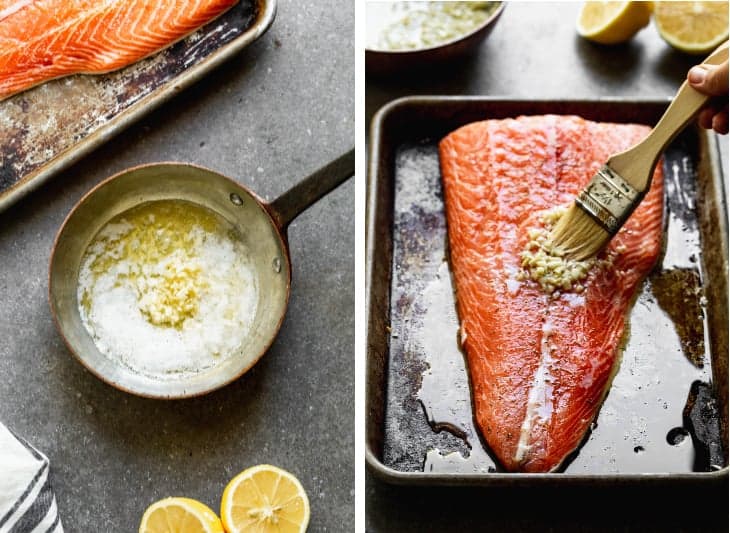
Do’s and Dont’s for Baked Salmon:
- DO Buy High Quality Salmon. There are several types of salmon, including: King salmon (Chinook), silver salmon (coho), pink salmon (humpback), red salmon (sockeye), and Atlantic salmon. Any of these types of salmon can taste delicious baked in the oven.
- DOCheck for Freshness.
- Salmon filet– if you are buying a salmon filet at the store, choose a filet with firm flesh. Give it a poke! Gently press the fillet with your finger and if it springs back, this is a good sign. If you’r fingerprint lingers in the fillet, choose a fresher fish. Also, look for a brightly orange-red hue in the fillet and nicely marbled skin. Look for darkening around the edges of the fish or brown/yellow discoloration in the flesh of the fish. These are NOT signs of freshness.
- Whole Salmon – First look in its eyes–no really! Take a look at the eyes of the salmon and choose a salmon with clear, bright eyes over cloudy, sunken eyes. Clear eyes is a good indicator of freshness. When you hold the fish, also look for the flesh to feel firm, not floppy.
- Smell the fish! This is a huge indicator of freshness! You want to avoid salmon that has a strong fishy smell. It should have a mild, salt-water or sea smell.
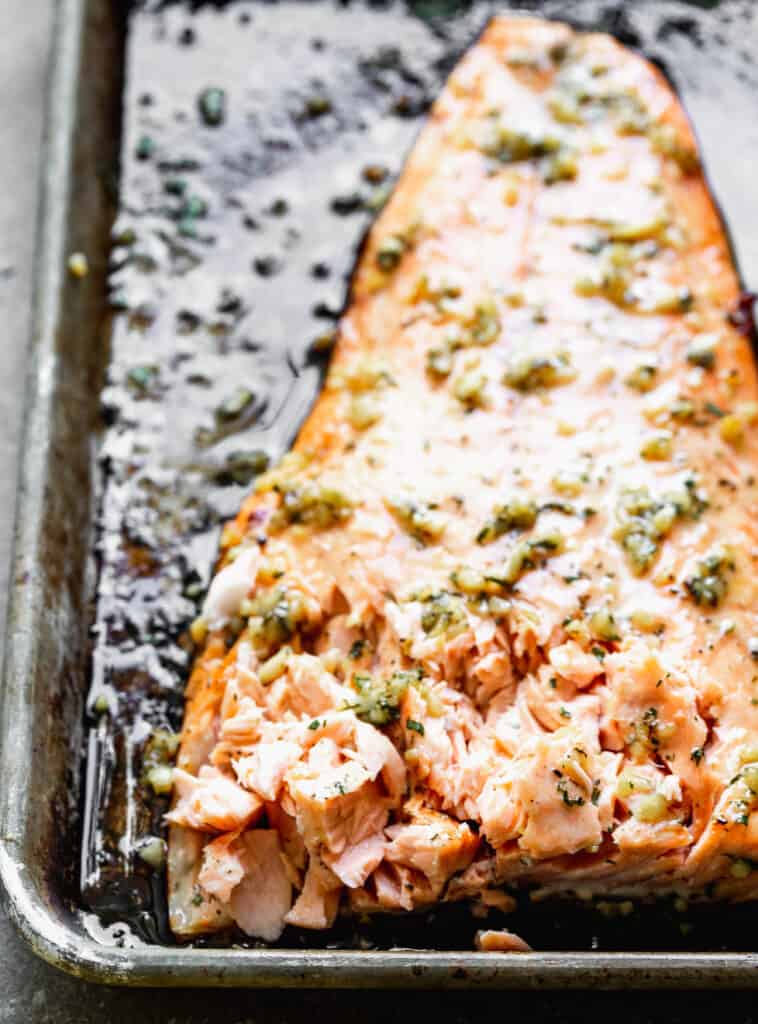
- DOThaw Salmon Properly.
- Fresh fish- After purchasing fresh fish, store it in the refrigerator until ready to use (it typically should be used within two days). Before baking, be sure to let the fish sit at on the counter until it comes to room temperature. This will allow it to cook more evenly.
- Frozen fish- to thaw frozen fish, either let it say in the refrigerator overnight or, for a quicker defrost, place it in a sealed bag under cold running water until thawed. It’s important not to use hot water or any type of heat to that your salmon! Allow it to come to room temperature before baking.
- DO Remove the Bones, If Needed. Before baking, gently run your fingers over the fillet of the fish to feel for ends of the bones that may be sticking out. If you notice bones, you can use needle-nose pliers to carefully remove them.
- DOSeason It, But Not Too Soon!
- Unlike beef and chicken where we love to apply a marinade for an hour or longer, with salmon, we don’t want to add the seasoning (particularly salt) too early. salt will may draw out to much moisture if left for an extended period of time. For best results, season salmon just before baking.
- In the recipe card you will notice I’ve provided 3 of my favorite salmon seasonings; Lemon and dill, garlic butter, and cajun seasoning.
- DON’T Rinse Salmon. Washing your raw fish is unnecessary, and may spread bacteria to your sink or other parts of your kitchen. Any bacteria that may reside on the fish will be killed when it’s cooked in the hot oven. Also, water can can break down the flesh of the salmon. Instead of rinsing with water, gently pat the salmon all over with a paper towel.
- DON’T Remove the Skin Before Baking. Most people prefer their salmon without the skin, however you should still leave the skin on your salmon until you’ve baked it. Always bake salmon with the skin side down as this will help protect the fillet from the heat of the pan and it will help the salmon retain its juices and cook evenly. When it’s time to serve the salmon, the skin will come off really easily as you slide a spatula between the fillet and the skin.
- DON’T Overcook. Possibly the worst thing you can do is over cook your salmon. Most restaurants serve salmon medium rare though some prefer it cooked a little longer. Ideally, remove salmon from the oven before it’s “done” as it will continue cooking while it rests. Cook time will vary as salmon fillets vary in thickness. If you have a thermometer, aim for about 140 degrees F (per USDA recommendations). You can also check for doneness by using a sharp knife and peeking inside the thickest part of the fillet. It should look opaque and the layers within the salmon should flake apart easily.
Recipe Variations:
- Garlic Butter – a mixture of garlic, butter, chicken broth, lemon juice, and honey.
- Lemon & Dill – a mixture of butter, lemon juice, lemon zest, garlic, dill, salt, and pepper
- Cajun Seasoning – I love McCormick’s Cajun seasoning!
- Baked Teriyaki Salmon – Pour some Teriyaki Sauce on top of the salmon before baking!
- Cedar Plank Salmon.
- Air Fryer Salmon: We love cooking Salmon in the air fryer, and Well Plated has an amazing recipe!
- Grill Salmon: if you want to learn How to Grill Salmon, Fit Foodie Finds has a great recipe.
Serve With:
- Roasted Vegetables or Hericot Verts
- Classic Wedge Salad or Tomato Cucumber Salad
- Perfect Mashed Potatoes
- Garlic Knots or the Best Homemade Rolls
- Fresh Fruit Salad
- On a Buddha Bowl
Follow me for more great recipes
Recipe
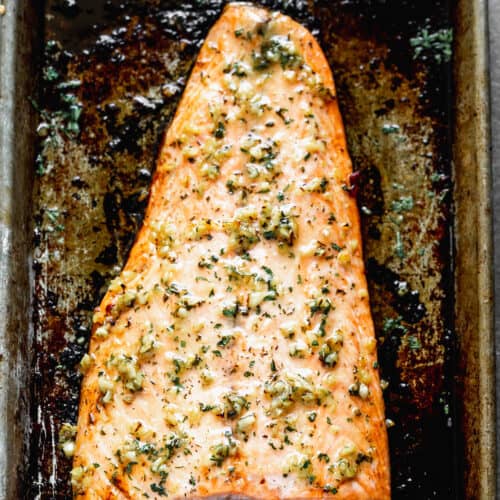
Baked Salmon
Ingredients
- 1 1/2-2 lbs salmon fillets
- salt and freshly ground black pepper
For Garlic Butter Sauce:
- 3 tablespoons butter , melted
- 3 cloves garlic , minced
- 1/4 cup low sodium chicken broth , or dry white wine
- 2 Tablespoons lemon juice
- 1 teaspoon honey
- fresh chopped parsley and lemon slices , for garnish, optional
For Cajun Seasoning:
- cajun seasoning
- olive oil
For Dill Seasoning:
- 1/2 cup butter melted
- 2 tablespoons freshly squeezed lemon juice
- 2 teaspoons lemon zest
- 3 cloves garlic , minced
- 1 tablespoon dried dill weed (or ¼ cup fresh dill, chopped)
Instructions
- Rest salmon. Set salmon on counter and allow it to rest for 20-30 minutes to come to room temperature. Pat with a paper towel.
- Sheet Pan or Aluminum foil: Lightly spray a sheet pan with non-stick cooking spray and place fillet on top, skin side down. Alternately, spray a large piece of aluminum foil with non-stick cooking spray and place fillet on top, skin side down, and then place on a baking tray.
- Prepare Desired Seasonings, and spoon over fillet. For Garlic butter: Melt butter in a small saucepan over medium heat. Add garlic and sauté for 30 seconds. Add chicken broth and lemon juice. Cook for 3-5 more minutes to reduce the sauce. Stir in honey. For Dill: Combine all ingredients in a small bowl.For Cajun seasoning: spread olive oil over filet and sprinkle a thin, even layer of cajun seasoning all over the top of the fillet.
- If cooking in foil, lift up all four sides of the tinfoil and seal together to create a pouch, to seal in the juices while the salmon bakes.
- Bake at 400 degrees F for 12-15 minutes depending on thickness of salmon. For best results, test for doneness using a thermometer. Aim for no more than 140º F as the salmon will continue to cook after removing it from the oven. Or, use a fork to gently pull back on a section in the thickest part of the filet. The salmon should flake away easily and look opaque.
Notes
Nutrition
Did You Make This Recipe?
Tag @TastesBetterFromScratch on Instagram with #TastesBetterFromScratch!
Follow Me
*I originally shared this recipe September 2013. Updated October 2019 and March 2022.
This post contains affiliate links.
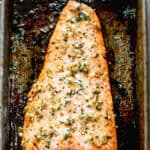
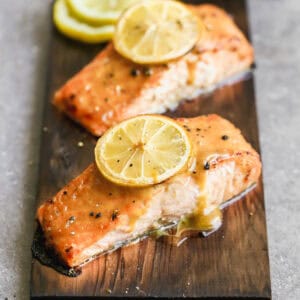
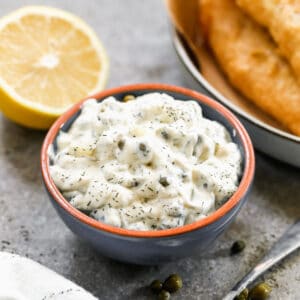

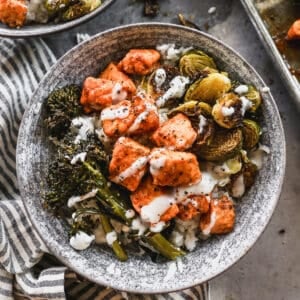
This recipe was shot with my family, I will definitely use it again. I didn’t have fresh parsley so I used dried and also sprinkled a little dry dill, as well. I served with fresh asparagus, white rice, and rosemary bread.
I need all the help I can get with easy but different meals I live by myself
Entrusted our king salmon to this recipe, and turned out great! I made the lemon garlic sauce and added capers. I did cook for less time to get medium rare, about 8 minutes.